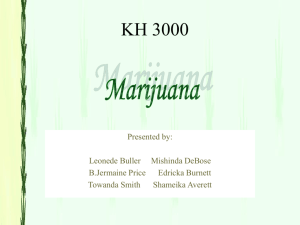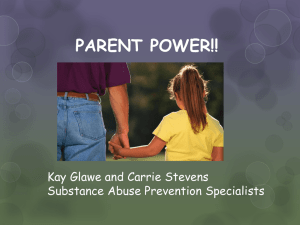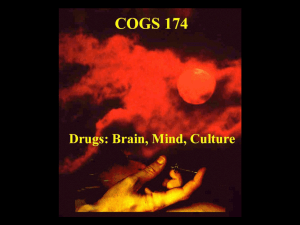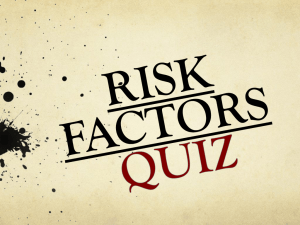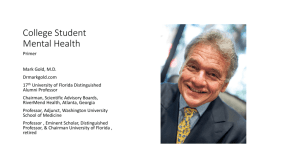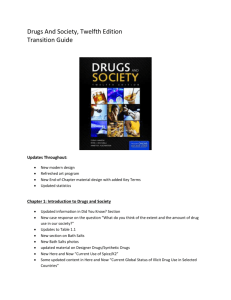Teens and Alcohol and Other Drug Use
advertisement
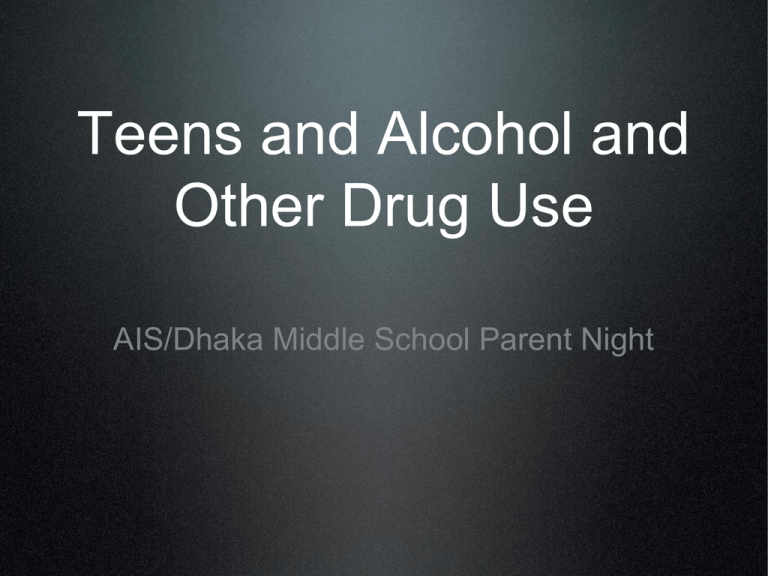
Teens and Alcohol and Other Drug Use AIS/Dhaka Middle School Parent Night Objectives • To develop an awareness of teen use of alcohol and other drugs in the AIS/D community. • To present and share ideas and strategies to help your child make intelligent decisions about alcohol and drug use. Agenda • Self Reflection • Personal Experience Panel • Middle School Health Program/Data • Common Language • Signs to look out for • Developing and sharing strategies • Workshop Debrief Self Reflection • When do you first remember being exposed to mind altering substances? Personal Experience Panel: Purpose • Purpose: • To hear the stories and experiences related to a particular issue(s). • To increase the listener’s understanding of an issue(s). • To help us attach personal significance and commitment to a particular issue Personal Experience Panel: Guidelines • Guidelines: • Each person is given equal time to talk. • The listener does not interpret, paraphrase, analyze, give advice or break in with a personal story. • Confidentiality is maintained. Introducing Personal Experience Panel • Julia Koczot- gr. 11 • Michino Hisabayashi- gr. 12 • Zaraif Hossain- gr. 11 • Ishaba Haque- gr. 11 Middle School Health Program/Units • Tobacco • Alcohol • OTC`s • Prescription Drugs • Illicit Drugs MS [Gr 7/8] • Use, misuse and abuse of drugs. • Effects drugs have on our bodies, minds and on society. • Alternatives to drug use, treatment programs available for those addicted to drugs. • Refusal skills, situations to avoid “wise decision making” US Public School Data • Tobacco use. . . • There is a link between smoking and drug/alcohol use among students • Alcohol and other drugs . . . • Alcohol is the #1 drug problem among young people • 50% of automobile accidents, violence, suicide, and sexual involvement are the result of alcohol use Alcohol • 78% of U.S. high school students have consumed alcohol (more than just a few sips) by the end of high school • Source: National Institute on Drug Abuse Marijuana • 38% of all U.S. high school seniors have used marijuana in the last 12 months. • 89% say marijuana is “fairly easy” or “very easy” to get. • Source: National Institute on Drug Abuse Illicit Drugs • 53 % of American young people have tried an illicit drug by the time they finish high school. • Source: National Institute on Drug Abuse Ecstasy • Club drugs such as ecstasy can lead to depression, drug cravings, paranoia (and in some cases psychotic episodes), blurred vision and dangerous increases in heart rate and blood pressure. • Source: National Youth Anti-Drug Media Campaign DRUG SITUATION IN BANGLADESH • Bangladesh is not a major producer of narcotics, but is a trans-shipment point. • Use and addiction rates among the local population have increased. • Illegal substances are easily available at a very low cost. WHAT IS READILY AVAILABLE? • low grade heroin (brown sugar) (smoked) • Marijuana • Hashish • phensidyl (codeine-based cough syrup) • PCP (angel dust) Where are drugs sold? • Drugs can be bought anywhere at drug houses in Mohammadpur, tea stalls, Banga Bazaar, from rickshaw drivers, restaurant back doors, Nuton Bazaar, Kalachanpur and Badha behind Baridhara. • The cough syrup, imported from India, can be bought at most pharmacies. Common Language- A Continuum of Use • Abstinence • Experimental Use • Social Use • Regular Use • Problem Use • Chemical Dependency Common Language- A Continuum of Use • Abstinence: No use • Experimental Use: “I heard about it.” “I want to find out how it feels.” “I want to try it out” • Social Use: Strictly for social use with friends. Will drink or use other drugs with friends. • Regular Use: Continual access to supply. Ritualized. Routine. Every night at dinner or almost every time hanging out with friends. • Problem Use: Begin having problems with school, work, and/or family resulting from use. Problems with competence or with meeting challenges. • Chemical Dependency: See next slide Continuum of Use Chemical Dependency • Creates problems for an individual, and he or she continues to use anyway. • Afraid to talk about his/her chemical use, is hiding it, or is defensive when others bring up the subject. • When a person uses alcohol or other drugs to achieve a feeling of normal well-being. • Chemical controls the person rather than the person controlling the chemical. • When a person craves alcohol or drugs for no good reason. • When a person is in love with a chemical and their primary relationship is with his/her drug of choice. Signs to look for • Mood Swings & Attitude • New Friends • Bad Performance in school • Physical Health • “Evidence” • Increased Secrecy • Little Things - fashion, hairstyle, breath mints, untidy room • Overt Signals Parenting Strategies • Set appropriate limits: based on your child’s needs, capabilities, age, and trust. • Enforce limits: establish clear, specific limits and follow through with consequences. • Continue relationship building: approach your children with a sense of love and trust. Expect the best not the worst. • Team parenting: be predictable and work as a team. • Modeling: demonstrate healthy and appropriate behaviors at home and in social settings. • Communicate/Face it head on: talk openly to your teens about drugs and alcohol. Teach refusal skills. Resources/Websites • http://www.theantidrug.com • http://www.drugfree.org • http:// www.factsontap.org • http:// www.zeenteen.org • http:// www.girlsanddrinking.org • http:// www.cdc.gov • http:// www.toosmarttostart.com • http:// www.pubs.niaaa.nih.gov Resources/Books • Parenting for Prevention by David J. Wilmes • Choices and Consequences: What to Do When a Teenager Uses Alcohol/Drugs by Dick Schaefer • Teens Under the Influence: The Truth About Kids, Alcohol, and Other Drugs- How to Recognize the Problem and What to Do About It by Katherine Ketcham • Marijuana - What's a Parent to Believe? (Informed Parent) by MD Timmen L. Cermak • The Big Deal About Alcohol: What Teens Need to Know About Drinking (Issues in Focus) by Marilyn McClellan Debrief- Exit Cards • I learned… • I wish… • In the future, I would like to learn about…

